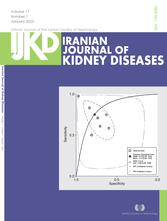Carotid Intima-media Thickness in Hemodialysis Patients and Related Biochemical and Clinical Factors
Abstract
Introduction. Cardiovascular complications are the most frequent cause of death in chronic kidney disease that happens due to both general and uremic risk factors. Recently, the medical literature has declared the carotid artery intima-media thickness to be an indicator for predicting cardiovascular diseases. Methods. This paper is an attempt to introduce an analytical cross-sectional study of 128 hemodialysis patients. The researchers collected the data by reviewing medical records, interviewing the patients, chemical analysis of the patient’s serum and carotid artery Doppler ultrasound, and providing the relevant questionnaire. We performed descriptive statistics, bivariate correlation, and general linear model (GLM) analysis. And, the significance level of hypothesis tests was .05. Results. Seventy-three patients (57%) were male, and 55 (43%) were female. The mean and standard deviation of the age was 58.66 ± 15.54 years. Nearly 42% of patients affected by diabetes, 95.3% were hypertensive and 28.1% had a history of cardiovascular disease. In the bivariate analysis, age, serum albumin, serum magnesium, hypertension, and history of cardiovascular disease showed a statistically significant relationship with carotid intima-media thickness (CIMT). In GLM, we observed a statistically significant relationship between CIMT, age and magnesium. Conclusion. Increased CIMT is observed in a considerable percentage of hemodialysis patients. Age and serum magnesium concentration demonstrate a statistically significant association with CIMT. We recommend more precise long-term longitudinal follow-up studies to investigate the relationship between biochemical risk factors and CIMT. Therefore, multivariate analysis is necessary to assess the simultaneous effects of independent variables and manage influences of confounding factors. We also recommend developing a practical guideline for periodic determination of CIMT in hemodialysis patients to implement convenient preventive or therapeutic measures.
DOI: 10.52547/ijkd.7303
Downloads
Download data is not yet available.
Downloads
Published
2023-02-01
Issue
Section
ORIGINAL | Kidney Diseases
How to Cite
Carotid Intima-media Thickness in Hemodialysis Patients and Related Biochemical and Clinical Factors. (2023). Iranian Journal of Kidney Diseases, 17(1), 28-36. https://ijkd.org/index.php/ijkd/article/view/7303


